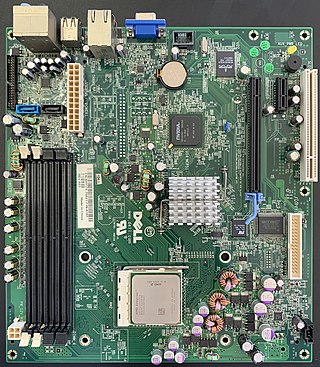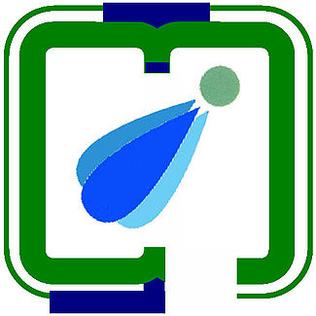Multimedia is a form of communication that uses a combination of different content forms, such as writing, audio, images, animations, or video, into a single interactive presentation, in contrast to traditional mass media, such as printed material or audio recordings, which feature little to no interaction between users. Popular examples of multimedia include video podcasts, audio slideshows, and animated videos. Multimedia also contains the principles and application of effective interactive communication, such as the building blocks of software, hardware, and other technologies. The five main building blocks of multimedia are text, image, audio, video, and animation.

Computer engineering is a branch of computer science and electronic engineering that integrates several fields of computer science and electronic engineering required to develop computer hardware and software. Computer engineering is referred to as computer science and engineering at some universities.

Augmented reality (AR) is an interactive experience that combines the real world and computer-generated content. The content can span multiple sensory modalities, including visual, auditory, haptic, somatosensory and olfactory. AR can be defined as a system that incorporates three basic features: a combination of real and virtual worlds, real-time interaction, and accurate 3D registration of virtual and real objects. The overlaid sensory information can be constructive, or destructive. This experience is seamlessly interwoven with the physical world such that it is perceived as an immersive aspect of the real environment. In this way, augmented reality alters one's ongoing perception of a real-world environment, whereas virtual reality completely replaces the user's real-world environment with a simulated one.

Motion capture is the process of recording the movement of objects or people. It is used in military, entertainment, sports, medical applications, and for validation of computer vision and robots. In filmmaking and video game development, it refers to recording actions of human actors and using that information to animate digital character models in 2D or 3D computer animation. When it includes face and fingers or captures subtle expressions, it is often referred to as performance capture. In many fields, motion capture is sometimes called motion tracking, but in filmmaking and games, motion tracking usually refers more to match moving.

Algonquin College of Applied Arts and Technology is a publicly funded English-language college located in Ottawa, Ontario, Canada. The college has three campuses, all in Ontario: a primary campus located in Ottawa, and secondary campuses located in Perth and Pembroke. It offers bachelor's degrees, diplomas, and certificates in a range of disciplines and specialties. The college serves the National Capital Region and the outlying areas of Eastern Ontario, Western Quebec, and Upstate New York. It has been ranked among the Top 50 Research Colleges in Canada and has been recognized as one of Canada's top innovation leaders. The enabling legislation is the Ministry of Training, Colleges and Universities Act. It is a member of Polytechnics Canada.

De La Salle–College of Saint Benilde, also known as DLS-CSB or Benilde, is a private, Catholic secondary and tertiary education institution established by De La Salle Brothers located in Malate district of Manila, Philippines. It operates four campuses all of which are located within the vicinity of Malate, Manila. The college is a member institution of De La Salle Philippines (DLSP), a network of 16 Catholic Lasallian institutions. Benilde is also a member of a 350-year-old international network of over 1,200 Lasallian educational institutions globally established by the De La Salle Christian Brothers in 82 countries.
Human-centered computing (HCC) studies the design, development, and deployment of mixed-initiative human-computer systems. It is emerged from the convergence of multiple disciplines that are concerned both with understanding human beings and with the design of computational artifacts. Human-centered computing is closely related to human-computer interaction and information science. Human-centered computing is usually concerned with systems and practices of technology use while human-computer interaction is more focused on ergonomics and the usability of computing artifacts and information science is focused on practices surrounding the collection, manipulation, and use of information.
A Bachelor of Information Technology is an undergraduate academic degree that generally requires three to five years of study. While the degree has a major focus on computers and technology, it differs from a Computer Science degree in that students are also expected to study management and information science, and there are reduced requirements for mathematics.

Digital signage is a segment of electronic signage. Digital displays use technologies such as LCD, LED, projection and e-paper to display digital images, video, web pages, weather data, restaurant menus, or text. They can be found in public spaces, transportation systems, museums, stadiums, retail stores, hotels, restaurants and corporate buildings etc., to provide wayfinding, exhibitions, marketing and outdoor advertising. They are used as a network of electronic displays that are centrally managed and individually addressable for the display of text, animated or video messages for advertising, information, entertainment and merchandising to targeted audiences.

The B. Thomas Golisano College of Computing and Information Sciences is one of the largest colleges at the Rochester Institute of Technology (RIT), and is home to the institute's computing education and research facilities. Golisano College is home to RIT's computer science, cybersecurity, information sciences and technologies, and software engineering departments, and to the Ph.D. program in computing and information sciences, and the School of Interactive Games & Media. Golisano College is housed in a 125,000 square foot facility, opened in 2003 on RIT's campus in Rochester, New York. In 2020, the facility added an additional 52,000 square foot building, which joins the original Golisano College on all three floors and houses the ESL Global Cybersecurity Institute.

It is sponsored Zayed University is a public university based in the United Arab Emirates. It was established in 1998. It is one of the three government-sponsored higher education institutions in the United Arab Emirates. It is named in honor of Sheikh Zayed bin Sultan Al Nahyan, the country's first president.
The School of Engineering and Applied Science (SEAS) at the George Washington University in Washington, D.C. is a technical school which specializes in engineering, technology, communications, and transportation. The school is located on the main campus of the George Washington University and offers both undergraduate and graduate programs.

Prime College is an information technology, management, and science college in Nayabazar (Khusibu) Kathmandu, Nepal, established in 2001. The college offers courses for BBA, BIM, BBS B.Sc. (CSIT) and CCNA.

Indian Institute of Information Technology, Design and Manufacturing, Jabalpur, also known as Pandit Dwarka Prasad Mishra Indian Institute of Information Technology, Design and Manufacturing, is an Indian Institute of Information Technology in Jabalpur, Madhya Pradesh, India that focuses on Information Technology enabled Design and Manufacturing.

The University of Houston College of Technology is the second largest among 13 schools and colleges at the University of Houston. It offers 11 undergraduate degrees and 12 graduate degrees throughout four different departments. In Fall of 2017, there were 6,520 students enrolled in the college. The University of Houston has a new building in Sugar Land, Texas, for the College of Technology; programs are being moved there and a couple of programs will solely be offered at that campus.
A Bachelor of Science in Information Technology,, is a bachelor's degree awarded for an undergraduate program in the information technology. The degree is normally required in order to work in the Information technology industry.

PrimeSense was an Israeli 3D sensing company based in Tel Aviv. PrimeSense had offices in Israel, North America, Japan, Singapore, Korea, China and Taiwan. PrimeSense was bought by Apple Inc. for $360 million on November 24, 2013.

Deerwalk Institute of Technology provides extensive undergraduate programs, namely the Bachelor of Science in Computer Application and Information Technology (B.Sc.CSIT) and the Bachelor of Computer Applications (BCA). These programs are affiliated with Tribhuvan University.
CIIT Philippines - College of Arts and Technology is a private, non-sectarian educational institution in the Philippines that at provides specialized and practical education with a focus on arts, technology, and business.

The Fraunhofer Institute for Telecommunications, Heinrich Hertz Institute, HHI, also known as Fraunhofer HHI or Fraunhofer Heinrich Hertz Institute, is an organization of the Fraunhofer Society based in Berlin. The institute engages in applied research and development in the fields of physics, electrical engineering and computer sciences.













